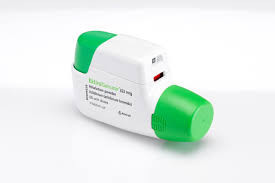Brand/Nama Lain
Ultibro Breezhaler, Seebri Breezhaler, dan Enerzair Breezhaler
Cara Kerja
Glycopyrronium adalah obat bronkodilator antikolinergik yang digunakan untuk mengurangi gejala Penyakit Paru Obstruktif Kronis (PPOK), seperti batuk, mengi, dan sesak napas. Bronkodilator adalah obat yang bisa melebarkan saluran napas bronkus, dan antikolinergik adalah golongan obat yang dapat digunakan untuk mengobati berbagai kondisi medis yang memengaruhi kontraksi dan relaksasi otot.
Pada penyakit paru obstruktif kronis, otot-otot di sekitar saluran udara berkontraksi dan membuat saluran udara menyempit, sehingga muncul gejala sulit bernapas. Obat ini bekerja dengan mencegah kontraksi otot-otot di sekitar saluran udara, sehingga udara akan lebih mudah masuk dan keluar dari paru. Obat ini mampu menekan efek asetilkolin pada otot pernafasan, sehingga saluran pernapasan menjadi lebih rileks dan lebar. Dengan begitu aliran udara menjadi lebih lancar dan keluhan dapat mereda.
Indikasi
Glycopyrronium diindikasikan sebagai bronkodilator (memperlebar luas permukaan bronkus pada paru) untuk meredakan gejala dan mengurangi perburukan kondisi penyakit. Obat ini biasanya diberikan pada pasien penyakit paru obstruktif kronik (PPOK) dengan gejala derajat sedang hingga berat. Obat ini hanya digunakan untuk mengontrol gejala dan mencegah kekambuhan, tidak digunakan untuk mengobati serangan sesak napas mendadak.
Kontraindikasi
Obat ini tidak boleh diberikan pada penderita yang memiliki kondisi:
- Pasien yang memiliki riwayat alergi atau hipersensitif terhadap glycopyrronium
- Anak usia <18 tahun
- Glaukoma (kondisi yang menyebabkan kerusakan pada saraf mata)
- Pembesaran kelenjar prostat
- Adanya obstruksi atau sumbatan pada lambung
- Miastenia gravis
- Pasien dengan masalah genetik, seperti intoleransi galaktosa, defisiensi Lapp laktase, atau malabsorbsi glukosa-galaktosa
Efek Samping
Beberapa efek samping yang dapat timbul akibat penggunaan glycopyrronium, antara lain:
- Sakit perut
- Diare
- Sembelit
- Sulit tidur
- Mual
- Rasa hangat pada wajah, leher, atau dada (flushing)
- Nyeri sendi atau nyeri punggung
- Mulut kering
- Sakit kepala
- Batuk
- Sakit tenggorokan
- Lelah yang tidak biasa dan kantuk
- Pandangan kabur
Tidak semua orang akan mengalami efek samping tersebut. Namun, efek samping di atas dapat diperburuk bersamaan dengan konsumsi alkohol.
Sediaan
Bentuk sediaan glycopyrronium antara lain:
- Larutan injeksi (0,2 mg/mL; bebas pengawet 0,2 mg/mL)
- Sirup (1 mg/5 mL)
- Tablet (1 mg; 1,5 mg; 2 mg)
- Tablet oral disintegrasi (1,7 mg)
Namun, di Indonesia glycopyrronium hanya tersedia dalam bentuk serbuk inhaler (50 mg).
Dosis
Dosis umum penggunaan glycopyrronium dalam bentuk alat hirup (inhaler) untuk orang dewasa adalah 1 kali hirup per hari atau setara dengan 50 mikrogram (mcg) glycopyrronium. Jika Anda menggunakan glycopyrronium sekali sehari, maka akan membantu mengurangi gejala penyempiran saluran pernapasan akibat PPOK.
Glycopyrronium direkomendasikan untuk diberikan pada waktu yang sama setiap hari. Jika dosis terlewat, dosis berikutnya harus diambil sesegera mungkin. Umumnya, pasien akan mendapat instruksi dari dokter untuk tidak mengambil lebih dari satu dosis dalam sehari.
Keamanan
Kehamilan:
Glycopyrronium dalam sediaan inhalasi (inhaler) termasuk dalam FDA Kategori C yang mengindikasikan bahwa obat berisiko menyebabkan gangguan kehamilan. Oleh karena itu, obat kategori C hanya dianjurkan jika manfaat yang diperoleh ibu maupun janin lebih besar daripada risiko yang ditimbulkannya.
Interaksi Obat
Berikut ini beberapa interaksi antarobat yang dapat terjadi apabila glycopyrronium digunakan bersamaan dengan obat lain:
- Peningkatan risiko efek samping yang serius dan fatal jika digunakan dengan obat antikolinergik lain, seperti ipratropium atau tiotropium
- Peningkatan risiko gangguan irama jantung jika digunakan dengan gas halothane
- Tidak boleh digunakan bersamaan dengan golongan obat blocker β-adrenergik, antikolinergik, MAOI, TCA, obat yang diketahui memperpanjang interval QT
- Peningkatan tekanan di dalam bola mata jika digunakan dengan kortikosteroid
- Peningkatan risiko terjadinya peningkatan suhu tubuh (hipertermia) jika digunakan dengan zinosamide atau topiramate
Mau tahu informasi seputar obat-obatan lainnya? Cek di sini, ya!
- dr Nadia Opmalina
Badan Pengawas Obat dan Makanan RI. Glycopyrronium. Retrieved 20 July 2024, from: https://registrasiobat.pom.go.id/files/assesment-reports/6739529961688541906.pdf
U.S. National Library of Medicine. National Institute of Health MedlinePlus. Glycopyrrolate Oral Inhalation. Retrieved 20 July 2024, from: https://medlineplus.gov/druginfo/meds/a618016.html
U.S. National Library of Medicine National Center for Biotechnology Information. Glycopyrrolate - C19H28BrNO3. Retrieved 21 July 2024, from https://pubchem.ncbi.nlm.nih.gov/compound/Glycopyrrolate
National Center for Biotechnology Information. Inhaled glycopyrronium bromide: a review of its use in patients with moderate to severe chronic obstructive pulmonary disease. Retrieved 22 July 2024, from https://www.ncbi.nlm.nih.gov/pubmed/23677802


/669df15fa3628.jpg)


/inhaler.jpg)






